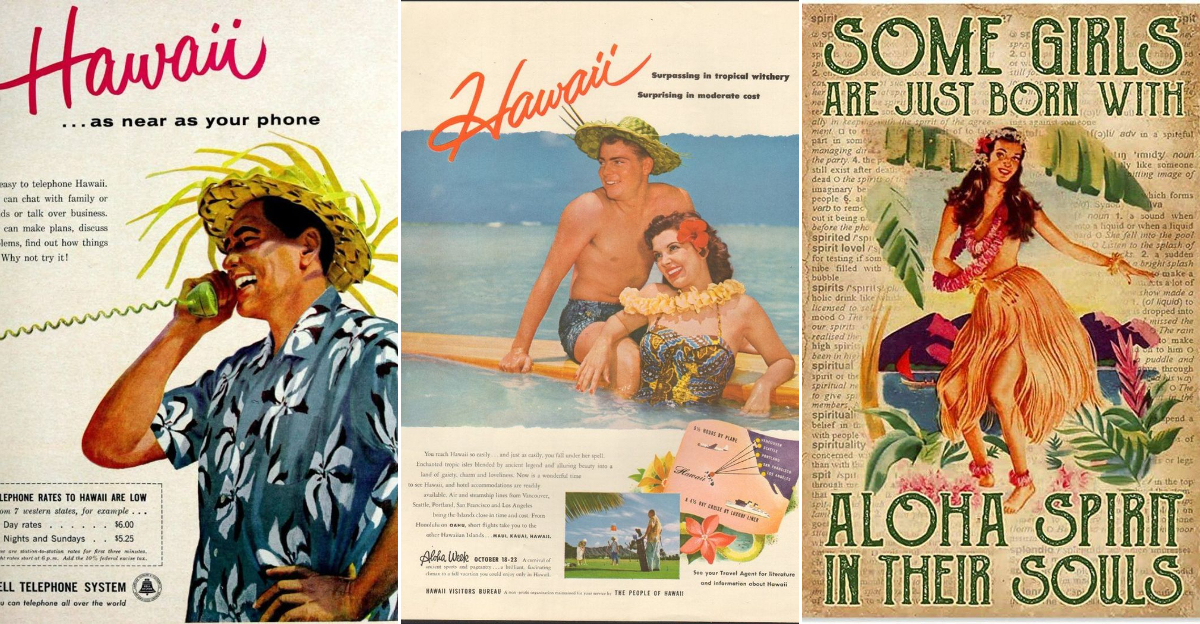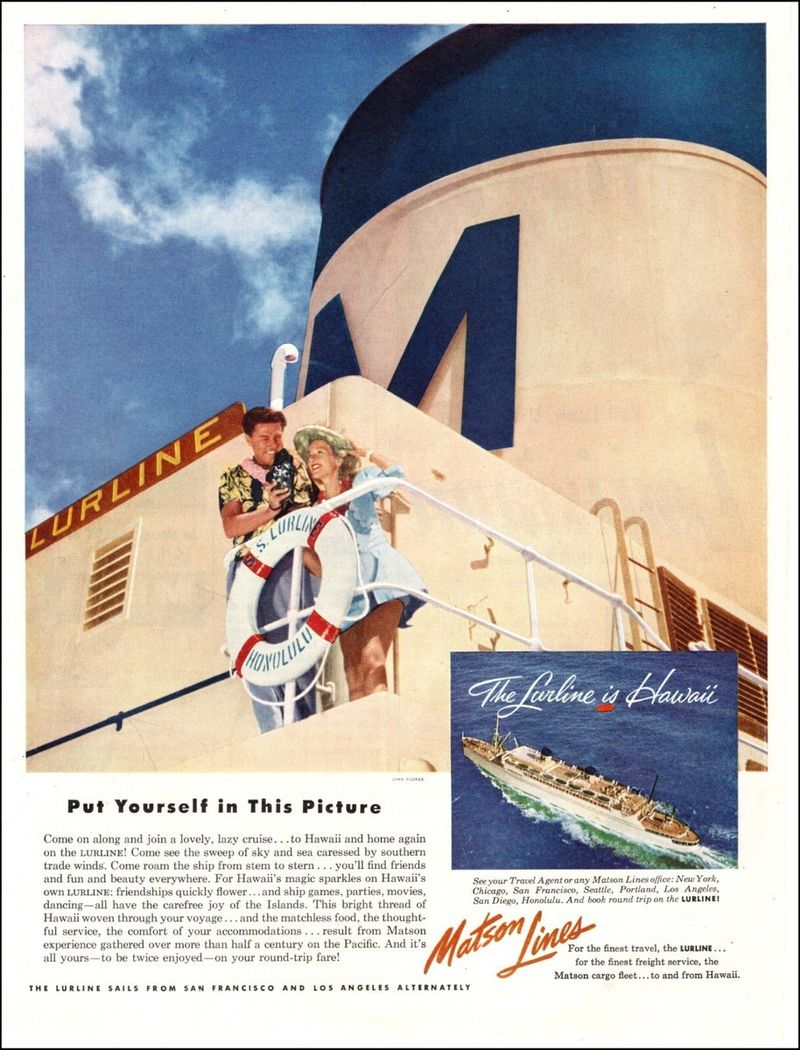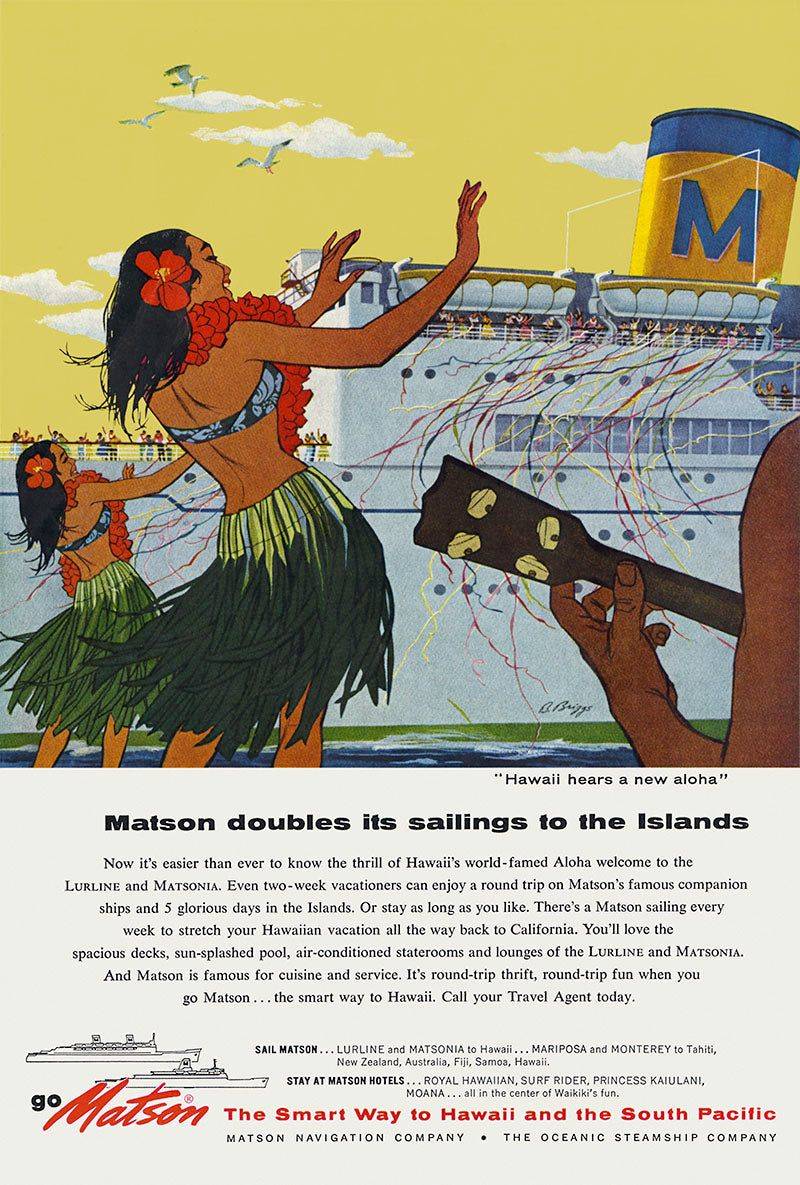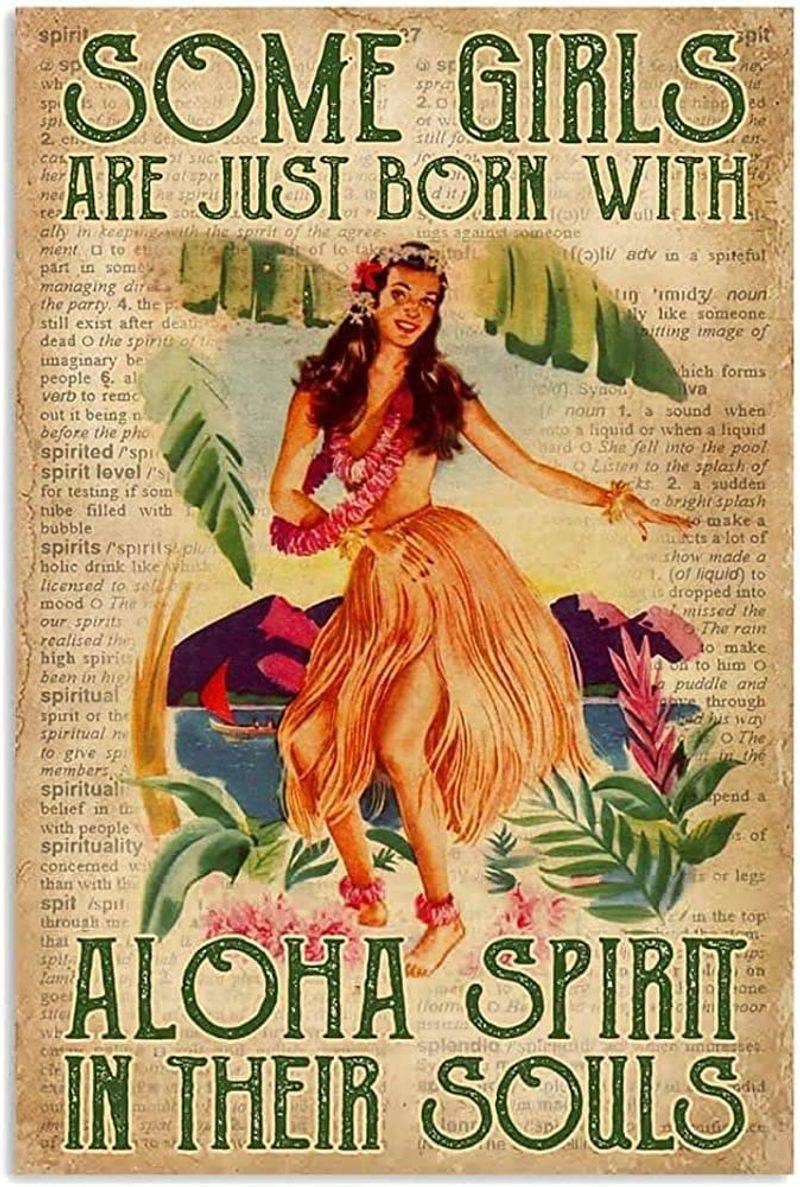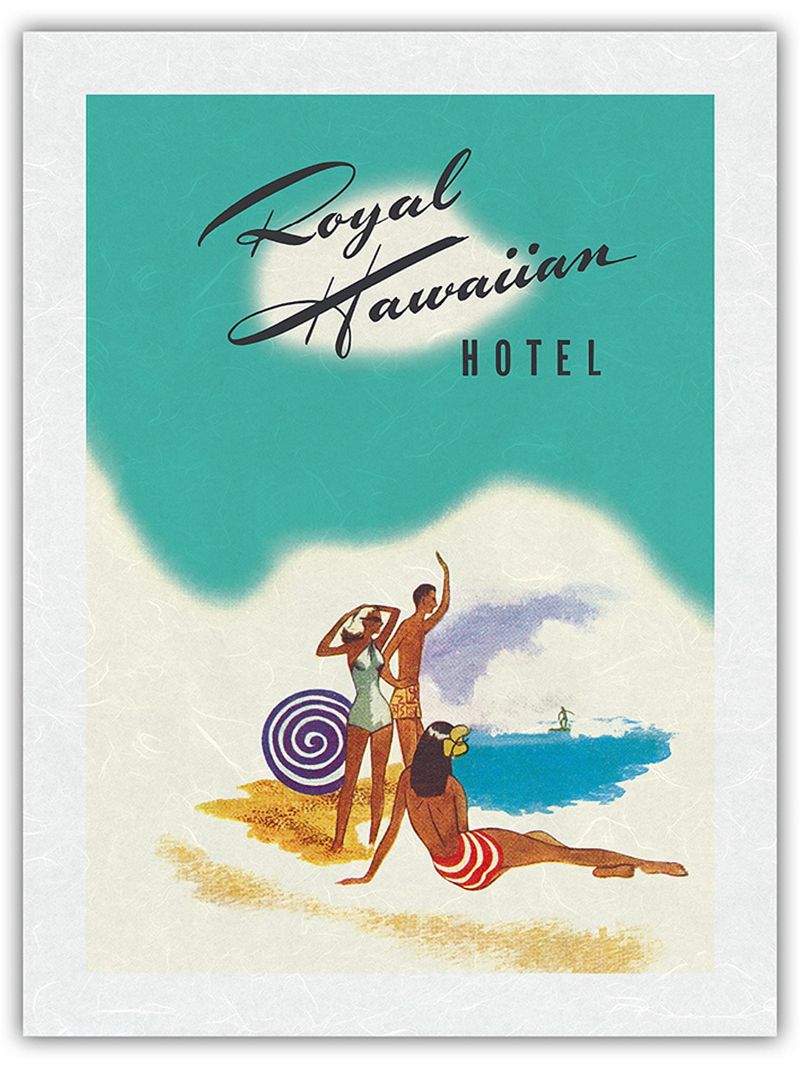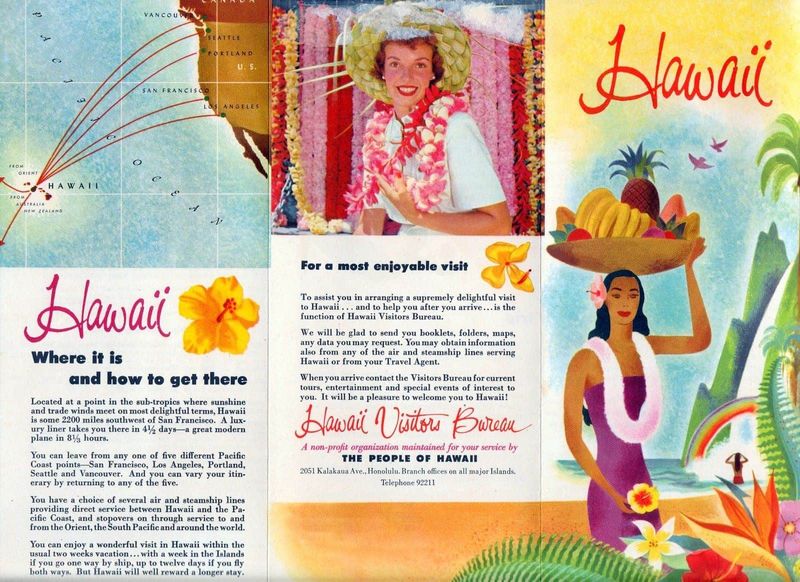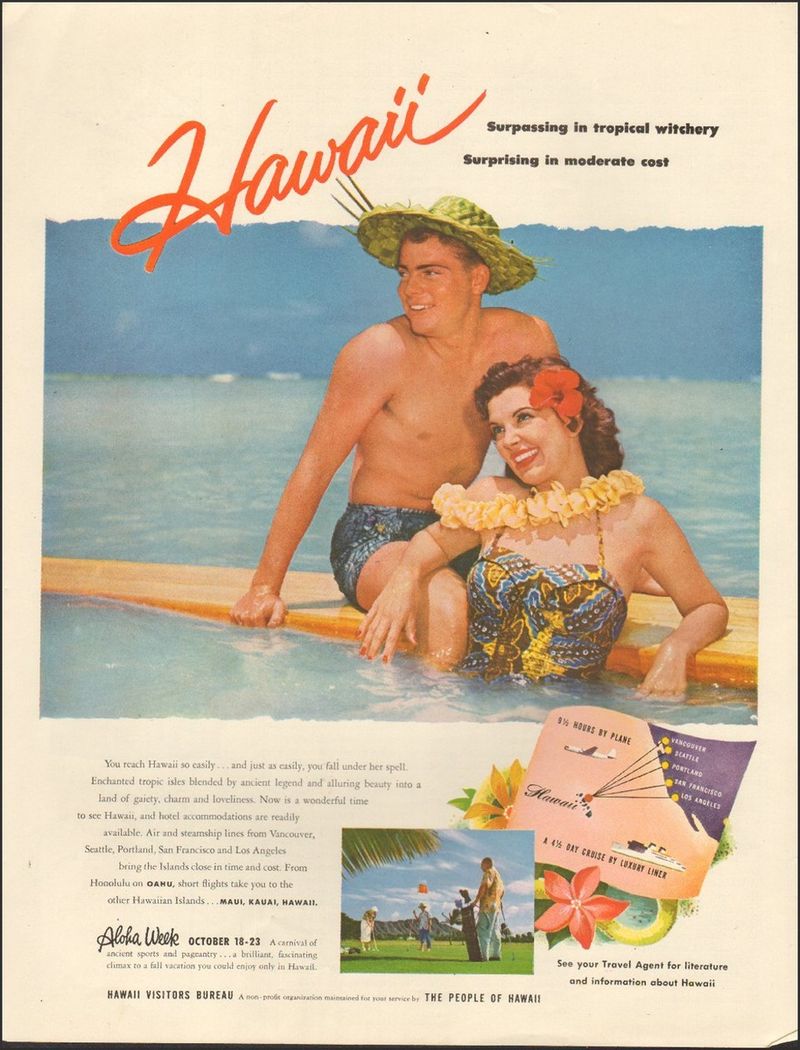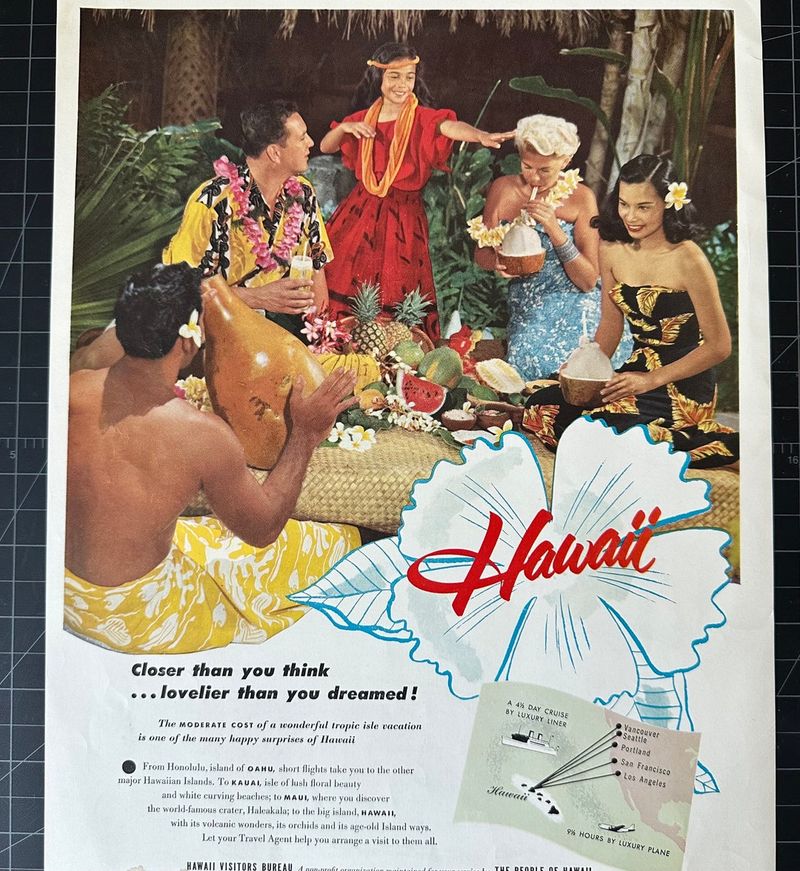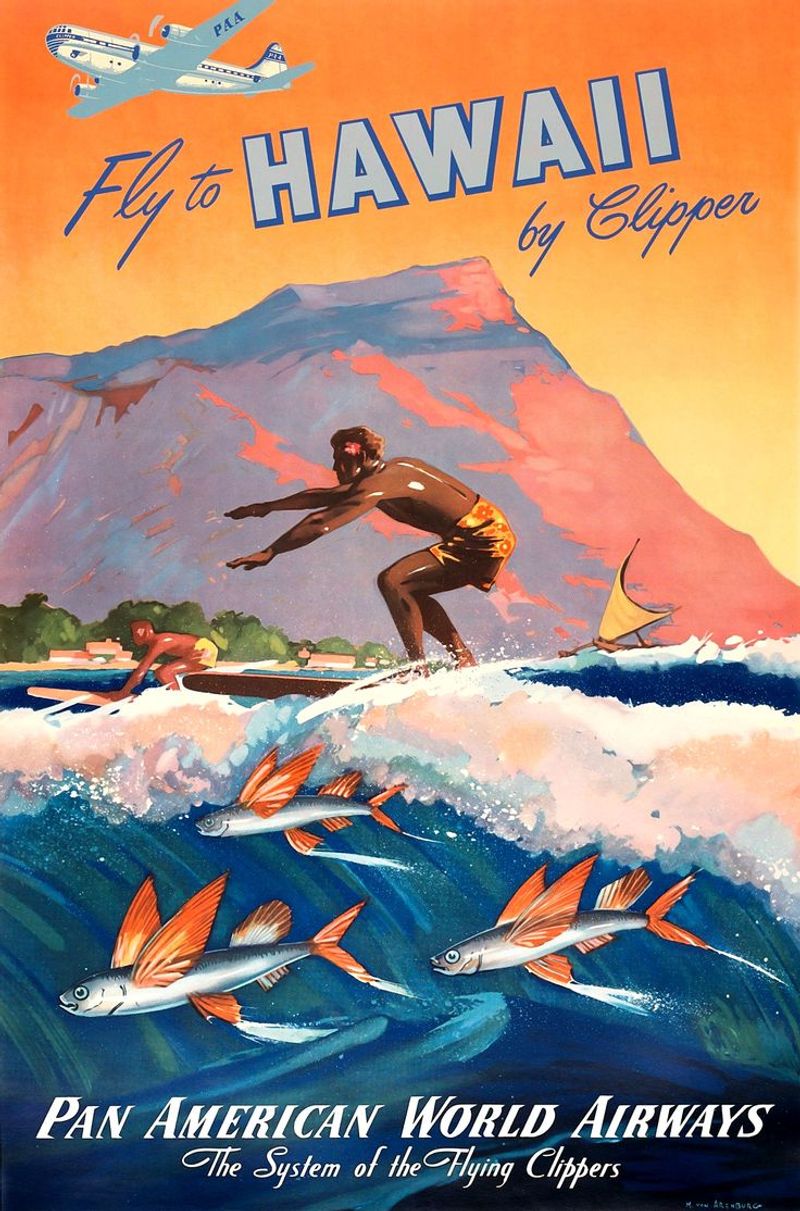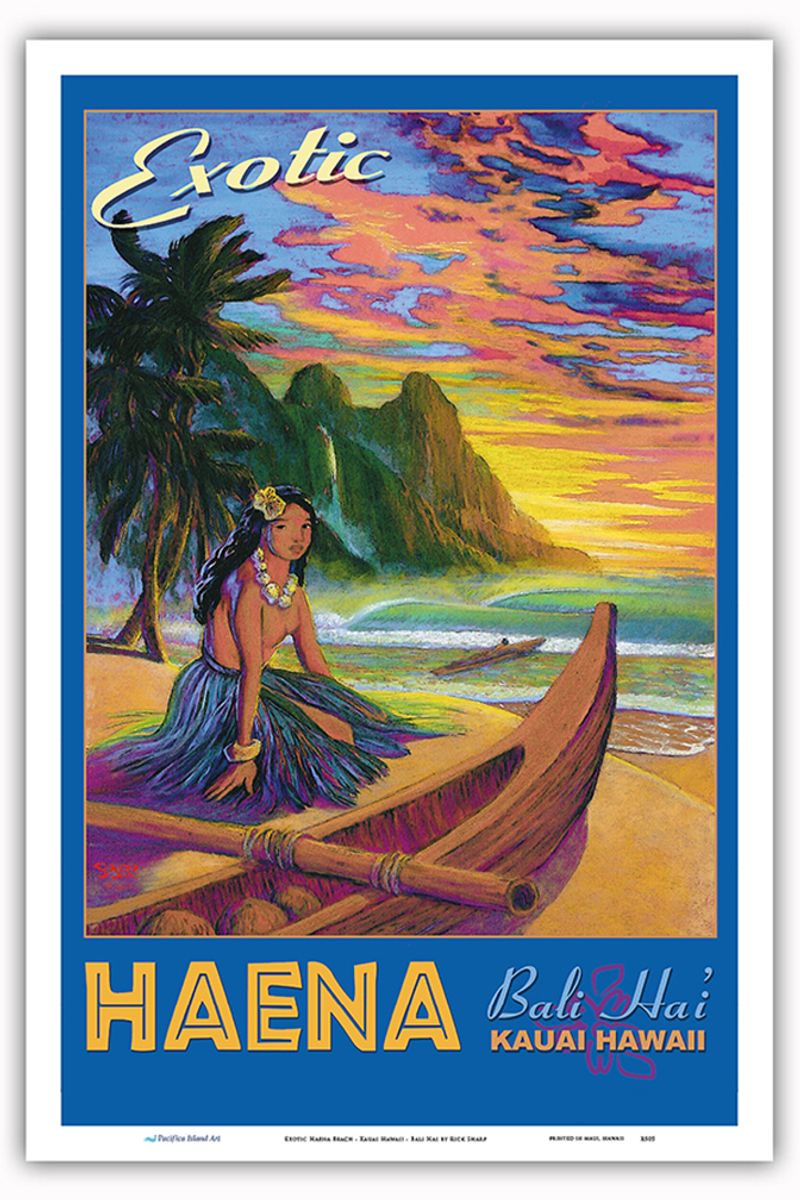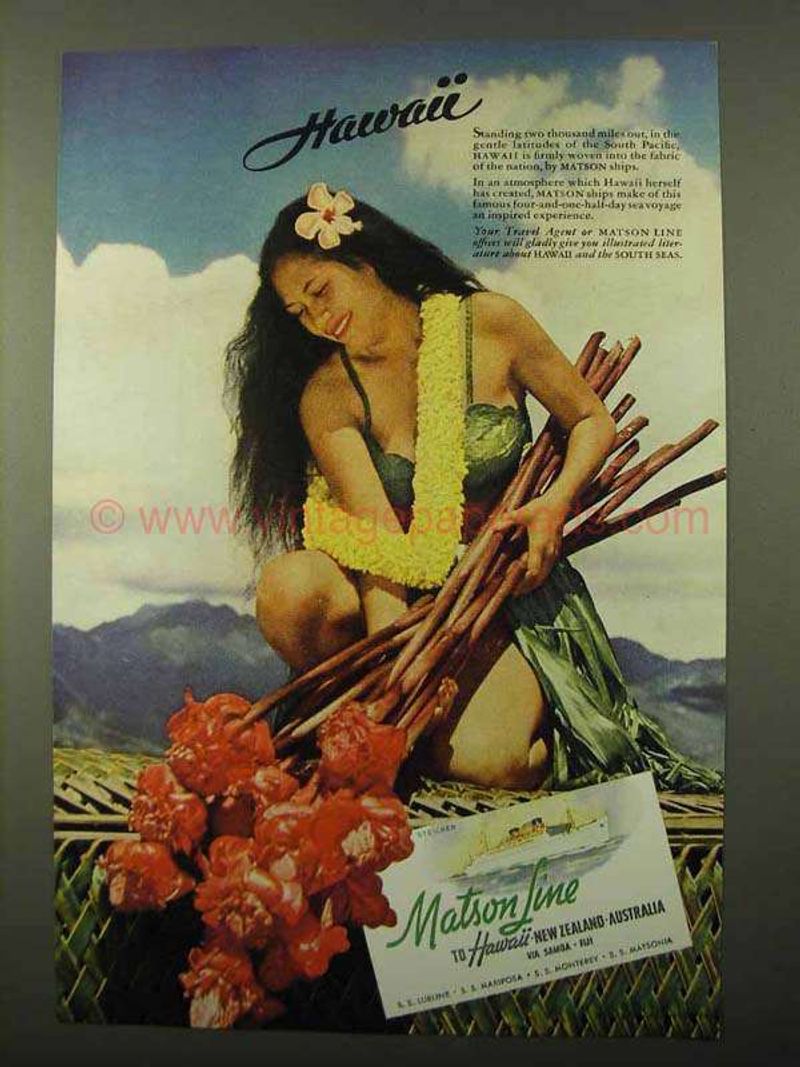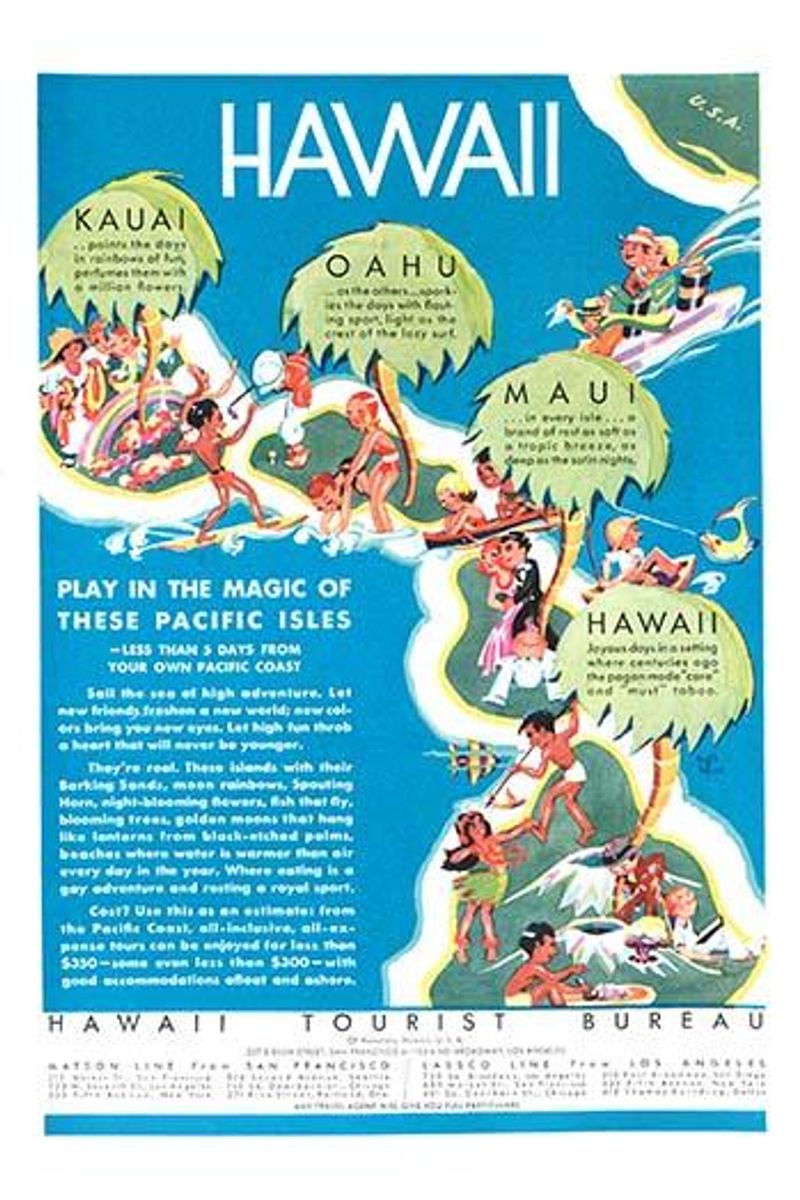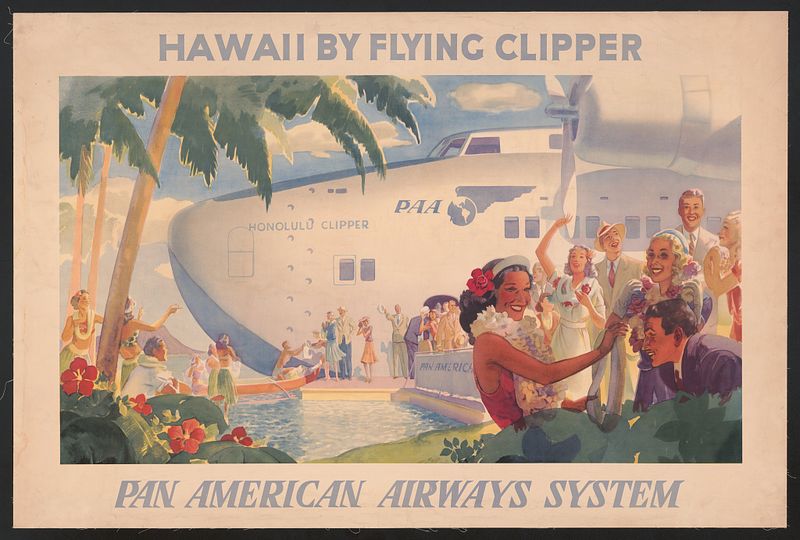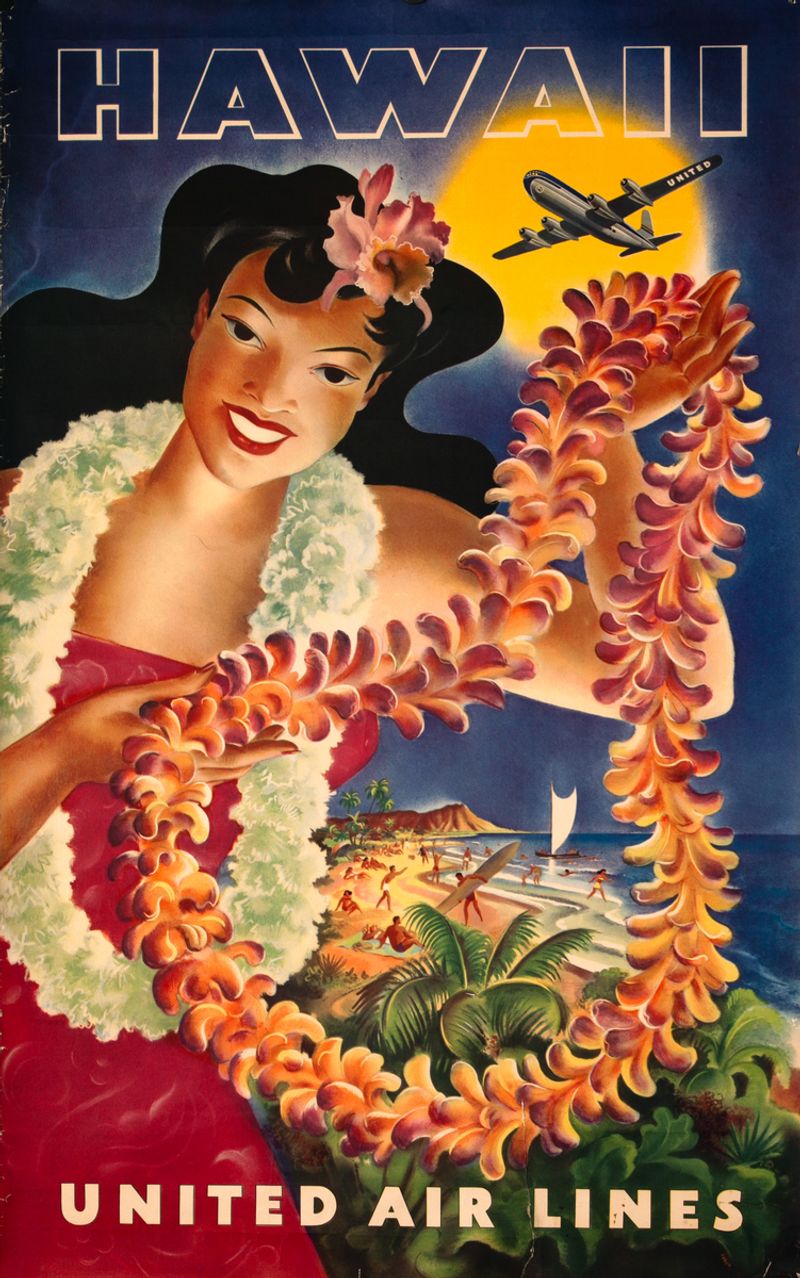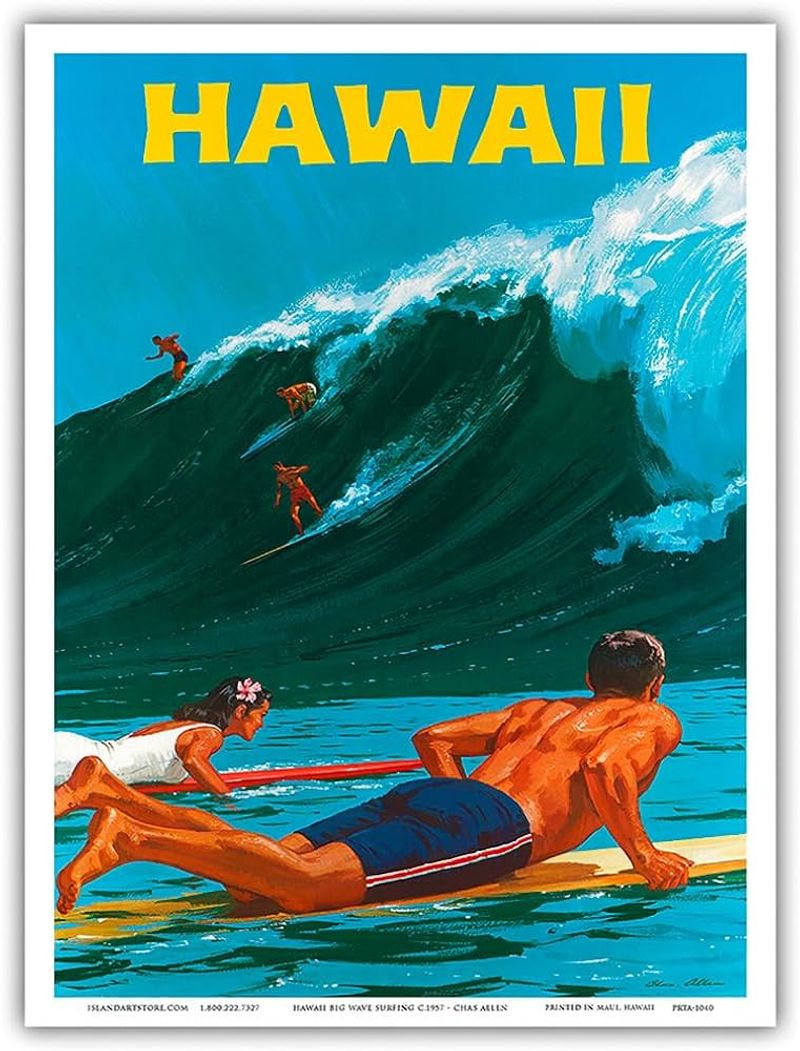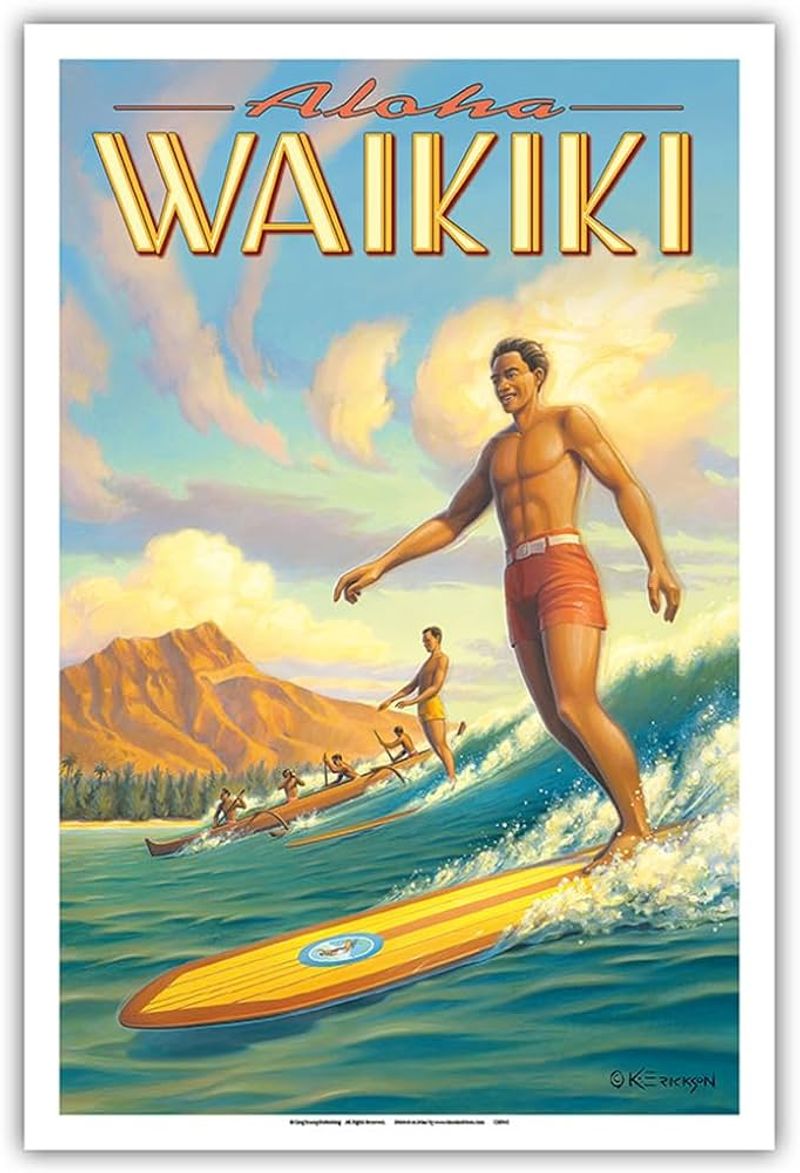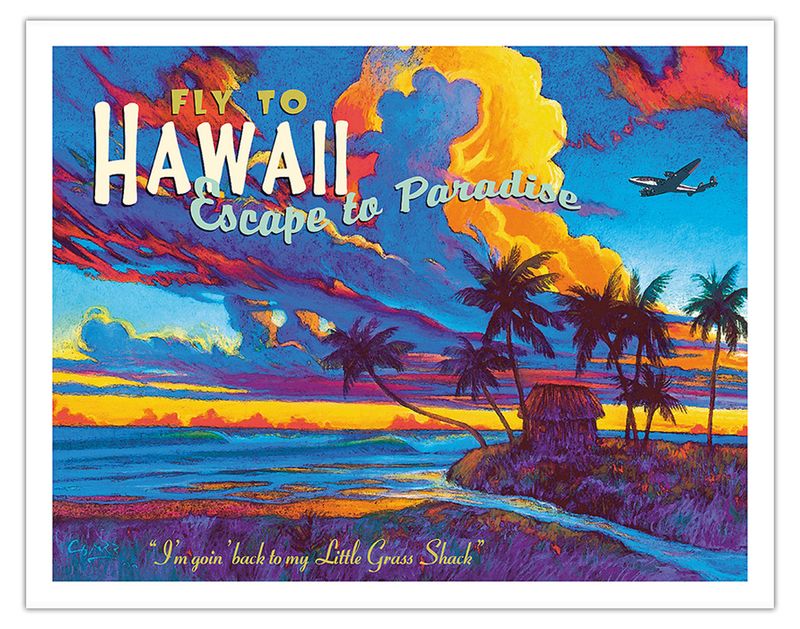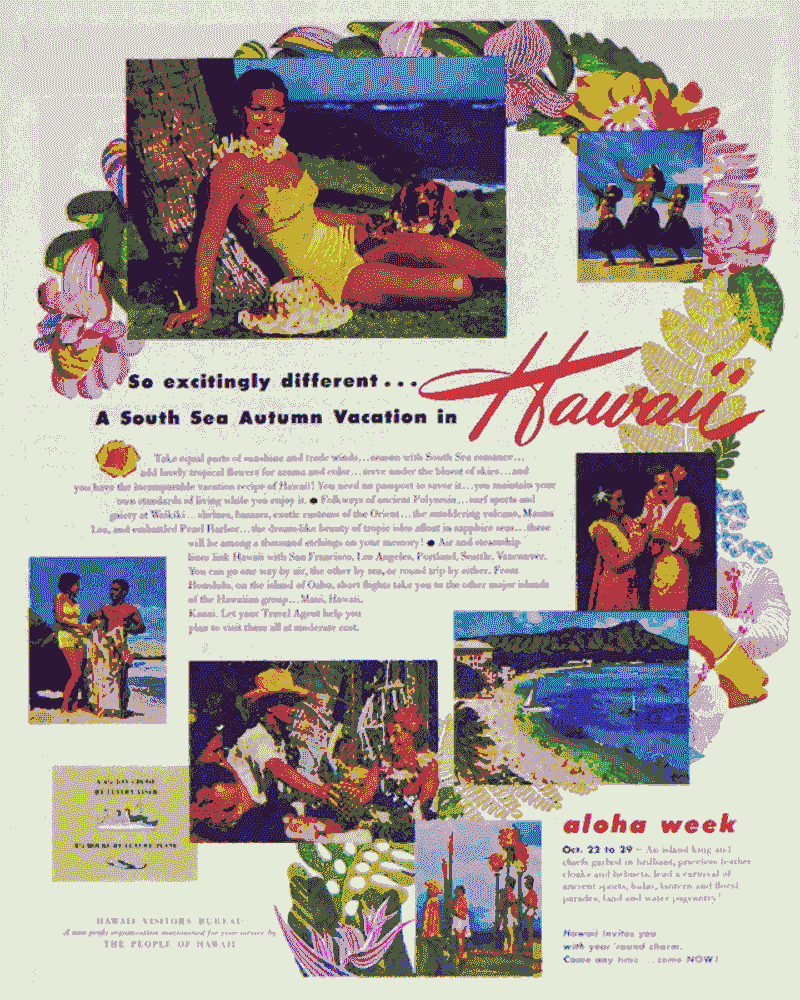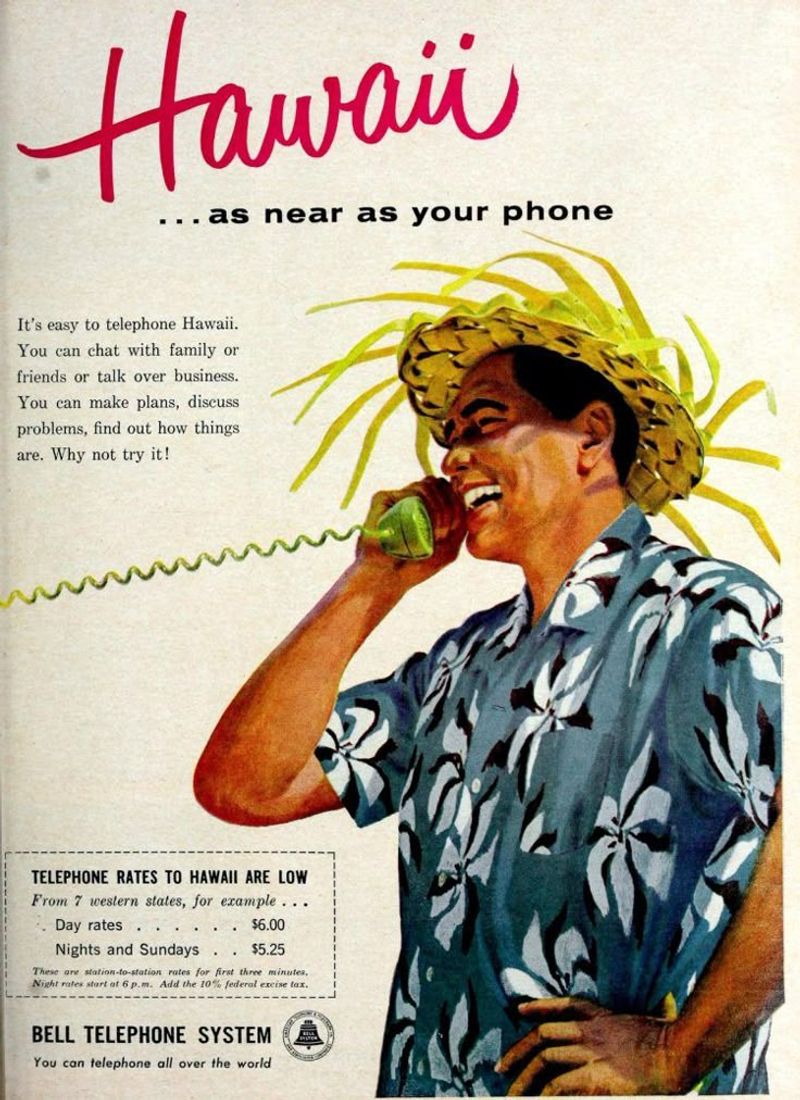Before Hawaii officially became America’s 50th state in 1959, it had already carved out a mythic place in the American imagination. Thanks to an aggressive wave of tourism marketing from the 1920s through the 1950s, the islands were sold as a fantasy—exotic yet accessible, ancient yet modern, wild yet welcoming. These 23 vintage Hawaii tourism ads weren’t just promoting vacations. They were shaping a mainland perception of paradise—and leaving a lasting legacy in travel culture that still resonates today. Here’s the story behind those sun-soaked posters and brochures.
1. Ocean Liners Were the First Way Tourists Reached the Islands
Imagine crossing the Pacific on a glamorous ocean liner, the ultimate luxury journey of its time. In the early 20th century, steamships like the Matson Line were the primary means to visit Hawaii. Ads featured elegant travelers alongside island imagery, enticing the wealthy to embark on a five-day voyage.
The allure of palm trees and hula dancers promised an enchanting escape. These voyages set the stage for Hawaii’s emergence as a dream destination, painting an exotic yet accessible picture. The liners were more than transport; they were part of the adventure itself.
2. The Matson Company Dominated Hawaii’s Tourism Imagery
In the vibrant tapestry of early 20th-century tourism, Matson Line’s advertising was undeniably influential. Their lush, romantic imagery painted Hawaii as an idyllic sanctuary, crafting visions of dreamy getaways. Matson’s posters became synonymous with the idea of a Hawaiian paradise.
By presenting Hawaii as both exotic and reachable, they captivated the imaginations of countless potential visitors. The company’s visual style, with its rich colors and charismatic designs, helped define the islands’ identity long before statehood. These ads left an indelible mark on the perception of Hawaii as a destination.
3. The “Aloha Spirit” Was Born in a Marketing Office
Aloha! More than a mere word, it became the cornerstone of Hawaii’s tourism brand. Marketing creatives transformed “aloha” into a promise of warmth and hospitality. This rebranding introduced visitors to a lifestyle filled with joy and connection, despite never truly capturing its cultural depth.
The ads presented Hawaii as welcoming and mysterious, yet always familiar. The notion of “aloha” resonated deeply, fostering a sense of belonging to both locals and tourists. This marketing magic paved the way for Hawaii’s iconic image, creating expectations of paradise fulfilled by a single word.
4. Hula Was Packaged for Mainland Audiences
Hula, a profound cultural expression, became an iconic feature of Hawaii’s tourism narrative. Advertisements frequently showcased young women in grass skirts, performing traditional dances against picturesque backdrops.
This visual simplification of hula resonated with mainland audiences, often overlooking its spiritual roots. It portrayed a carefree island life, aligning with tourists’ fantasies of escapism. While the real essence of hula was often lost, these images played a pivotal role in shaping Hawaii’s exotic allure. Such portrayals remain a testament to the powerful imagery that drew visitors to the islands.
5. Hotels Like the Royal Hawaiian Set the Tone
The Royal Hawaiian Hotel, affectionately known as “The Pink Palace,” epitomized luxury travel in Hawaii. Tourism ads of the era prominently featured this iconic hotel, representing the zenith of opulence and island living.
Its majestic architecture and serene location became symbols of paradise, luring travelers seeking extravagance. The hotel’s inclusion in marketing campaigns underscored its status as a must-visit destination. It set a high standard for hospitality, long before modern resorts emerged. This blend of elegance and tropical charm remains a significant part of Hawaii’s tourism legend.
6. Military Presence Helped Drive Tourism
The military’s influence on Hawaii’s tourism was profound, particularly during and post-WWII. Thousands of servicemen who passed through the islands returned as tourists, drawn by nostalgia and fond memories.
Ads cleverly targeted this demographic, playing on their familiarity with Hawaii’s unique charm. The shared experiences of military personnel helped create a sense of connection with the islands. The advertisements captured this sentiment, portraying Hawaii as a place of adventure and relaxation. The military presence thus indirectly boosted tourism, intertwining service and leisure in Hawaii’s story.
7. Hawaii Was Framed as America’s South Pacific Fantasy
During the mid-20th century, Hawaii was marketed as an exotic escape within America’s grasp. The narrative capitalized on the allure of the South Pacific without the complexities of international travel. Advertisements emphasized its exotic appeal while assuring safety and familiarity.
This portrayal resonated with travelers eager to experience the “Oriental” intrigue in a controlled environment. Hawaii’s geographical and cultural position offered a unique blend of adventure and comfort, making it a desirable destination. These ads successfully bridged the gap between fantasy and reality, drawing countless visitors to its shores.
8. Pre-Statehood Ads Targeted the Wealthy
In the days before statehood, traveling to Hawaii was a luxury reserved for the affluent. Tourism ads targeted this demographic, emphasizing exclusivity and sophistication. The imagery often highlighted lavish accommodations and personalized experiences.
Hawaii was a playground for the wealthy, a distant paradise that promised unmatched elegance and leisure. These early campaigns played to the desires of high society, entrenching Hawaii’s reputation as a premier destination. This perception of exclusivity not only attracted visitors but also set a precedent for the luxury market on the islands.
9. “Go Native” Was a Popular (and Problematic) Slogan
The phrase “Go Native” appeared in numerous tourism ads, inviting visitors to immerse themselves in island life. This slogan encouraged tourists to adopt local customs, clothing, and activities, albeit superficially.
The idea of “going native” romanticized Hawaiian culture while oversimplifying and commodifying it for tourists’ amusement. Such portrayals often trivialized genuine traditions, reducing them to mere entertainment. Despite its problematic nature, the slogan’s playful invitation contributed to Hawaii’s allure, offering a temporary escape from modernity. These ads reflect the cultural dynamics of tourism marketing in that era.
10. Pan Am Put Hawaii on the Air Map
The advent of air travel revolutionized Hawaiian tourism, with Pan American Airways leading the charge. Their Clipper planes offered unprecedented access to the islands, marking a new era of convenience and speed.
Sleek aviation posters depicted Hawaii as an accessible paradise, capturing the imagination of potential travelers. Pan Am’s routes reduced travel time dramatically, redefining the concept of a vacation. The airline’s advertisements portrayed a modern, adventurous spirit, making Hawaii a desirable and attainable destination for many. This transformation in travel dynamics significantly boosted tourism to the islands.
11. Surf Culture Was Just Emerging
In the early days of Hawaiian tourism, surf culture was gradually catching the mainland’s eye. Ads sometimes depicted surfers as daring adventurers, drawing attention to this exhilarating pastime.
Duke Kahanamoku, an Olympic swimmer and surfing legend, often featured as a symbol of the islands’ athletic and cultural spirit. His presence in advertisements highlighted Hawaii’s unique offerings, enticing sports enthusiasts. These early nods to surf culture sparked curiosity and laid the groundwork for Hawaii’s future as a surfing mecca. The allure of the waves became an integral part of its tourism narrative.
12. Pineapples and Sugarcane Were Visual Staples
Hawaii’s lush agricultural landscape played a significant role in its tourism imagery. Advertisements frequently featured pineapples and sugarcane, symbolizing the islands’ abundance and fertility.
These visuals tied the idea of tropical richness to the visitor experience, promising a land of plenty and prosperity. Pineapples, in particular, became iconic, often associated with Hawaiian hospitality. The agricultural imagery not only highlighted local industry but also added to the exotic allure of the destination. These ads contributed to the romanticized vision of Hawaii as both a bountiful land and a travel paradise.
13. The “Exotic Other” Was Heavily Marketed
Hawaii’s appeal lay in its promise of the “exotic other,” a place where travelers could experience new cultures without leaving the safety of U.S. borders. Ads leaned into this theme, presenting Hawaii as different yet accessible.
The cultural intrigue offered a taste of adventure, with the comfort of familiarity. This portrayal attracted those eager to explore new worlds while staying within a known environment. The marketing strategy succeeded in making Hawaii an alluring and mysterious destination, cementing its place in the American imagination as an exotic yet welcoming paradise.
14. Local Culture Was Repackaged for Tourism
Luaus, leis, and Hawaiian music were all adapted to fit tourist expectations, repackaging local culture for entertainment. Ads showcased these elements as must-have experiences, simplifying traditions for mainland visitors.
The allure of a luau, for instance, was marketed as a festive dinner, overlooking its cultural significance. Such adaptations catered to Western tastes, often overshadowing authentic traditions. Despite this, these portrayals were instrumental in drawing visitors, offering a tantalizing glimpse of Hawaiian customs. This repackaging remains a fixture of Hawaii’s tourism landscape, highlighting the balance between tradition and tourism.
15. The “Call of the Islands” Was Everywhere
A siren song of irresistible allure, the “Call of the Islands” resonated through various media—radio jingles, magazine spreads, and more. This captivating narrative pitched Hawaii as a must-visit paradise for honeymooners, artists, and the elite.
The messaging was clear: Hawaii was not just a destination but a life-changing experience. Ads conveyed the enchantment of the islands, drawing travelers into their warm embrace. This pervasive theme helped solidify Hawaii’s place as an ultimate escape, offering an alluring blend of adventure and romance. The “Call” became synonymous with Hawaii’s tourism appeal.
16. Government-Backed Tourism Grew Aggressively
Even before statehood, Hawaii’s territorial leaders recognized tourism as a vital economic engine. They collaborated with airlines, cruise lines, and publishers to craft a cohesive and attractive brand.
Government-supported campaigns highlighted Hawaii’s potential as a premier travel destination, emphasizing its unique offerings. These efforts laid the groundwork for a thriving industry, aligning local and business interests. By investing in tourism infrastructure, the government played a crucial role in shaping Hawaii’s future. The aggressive promotion not only boosted visitor numbers but also reinforced Hawaii’s identity as a sought-after paradise.
17. Magazine Ads Romanticized the Journey
National Geographic, Life, and other prominent publications featured Hawaii in stunning spreads, many crafted by tourism officials. The romanticized imagery depicted pristine beaches, lush landscapes, and cultural experiences.
These magazine ads connected readers to an idealized vision of Hawaii, blending adventure with relaxation. The allure of such narratives captured the hearts of those yearning for exploration. These spreads contributed significantly to Hawaii’s mystique, ensuring its place on travelers’ bucket lists. The media portrayal helped bridge the gap between imagination and reality, enhancing Hawaii’s reputation as a dream destination.
18. Women Were the Stars of Most Ads
In many vintage tourism ads, women played a central role, embodying Hawaii’s allure. Young, often racially ambiguous women appeared as symbols of beauty, seduction, and hospitality. Their presence conveyed a welcoming and enchanting atmosphere.
These portrayals emphasized the exotic charm of the islands, appealing to travelers’ fantasies. By presenting women as integral to the Hawaiian experience, the ads reinforced stereotypes while attracting visitors. This marketing strategy highlighted the allure of female beauty as both an invitation and a representation of the islands’ hospitality. These images remain iconic in Hawaii’s tourism history.
19. Tourism Was Already Replacing Agriculture
By the mid-20th century, tourism was rapidly overtaking agriculture as Hawaii’s economic backbone. Ads reflected this shift, emphasizing leisure and service over traditional industries. The narrative highlighted Hawaii’s new identity as a tourist haven.
This transformation signified a move towards a service-oriented economy, focusing on hospitality and recreation. The ads captured this evolution, portraying a future centered on visitor experiences. The transition from agriculture to tourism not only altered Hawaii’s economy but also its global image. These ads documented this pivotal change, marking a new era in the islands’ history.
20. Waikiki Became the Icon
Waikiki emerged as the quintessential symbol of Hawaiian tourism. Ads spotlighted its palm-lined beaches, stunning Diamond Head backdrop, and vibrant nightlife.
This focus transformed Waikiki into the must-visit location, despite Hawaii’s diverse offerings. The beach’s bustling atmosphere and picturesque scenery encapsulated the essence of paradise. Tourism campaigns elevated Waikiki’s status, making it synonymous with Hawaii’s allure. Its image as a tropical playground resonated with visitors, drawing them to its shores. This iconic representation remains a cornerstone of Hawaii’s tourism identity, reflecting both its historical significance and timeless appeal.
21. Travel Agencies Sold “Escape from Modern Life”
Amid the mid-century backdrop of urbanization and conformity, Hawaii represented an ideal antidote. Travel agencies marketed the islands as a serene escape from modern life, promising peace and adventure.
Ads portrayed Hawaii as a place to reconnect with nature and oneself, offering a respite from the hectic pace of city living. This narrative appealed to those seeking simplicity and rejuvenation. The promise of an idyllic retreat resonated with travelers yearning for a break from routine. The concept of escape became integral to Hawaii’s allure, reinforcing its status as a cherished destination.
22. The Statehood Push Leveraged Tourism
The bid for Hawaii’s statehood in the 1950s intertwined with its booming tourism industry. Ads leveraged this connection, portraying Hawaii as already part of the American landscape.
This strategic marketing emphasized the islands’ cultural and economic alignment with the mainland. It highlighted tourism as evidence of Hawaii’s integration and shared identity. The ads supported the statehood argument by showcasing Hawaii as familiar and welcoming. This campaign not only boosted tourism but also played a role in shaping public perception and political momentum. The narrative of belonging and unity became central to Hawaii’s story.
23. The Fantasy Worked—Tourism Tripled After 1959
The dream sold through decades of advertising culminated in a tourism boom post-statehood. Ads had successfully marketed Hawaii as America’s paradise, leading to a dramatic increase in visitors.
This surge reflected the power of the narratives crafted over the years, transforming Hawaii into a must-see destination. The advertising not only boosted tourism but also shaped Hawaii’s global image. The tripling of visitors post-1959 marked a new chapter in the islands’ history, fueled by the fantasies sold through vibrant ads. This growth underscores the lasting impact of pre-statehood marketing efforts.
